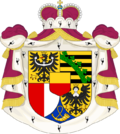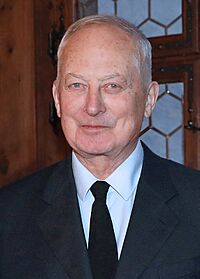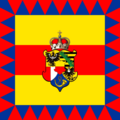Monarchy of Liechtenstein facts for kids
Quick facts for kids Prince of Liechtenstein |
|
|---|---|
| Fürst von und zu Liechtenstein (German) | |

|
|
| Incumbent | |
 |
|
| Hans-Adam II since 13 November 1989 |
|
| Details | |
| Style | His Serene Highness |
| Heir apparent | Alois |
| First monarch | Karl I |
| Formation | 20 December 1608 |
| Residence | Vaduz Castle |
The monarchy of Liechtenstein is how Liechtenstein is governed, with a Prince as its head of state. This means the Prince is the country's leader, and his position is passed down through his family. The current Prince is Hans-Adam II. The family that rules Liechtenstein is called the House of Liechtenstein. They got their name from Liechtenstein Castle in Austria, which they owned a long time ago. Liechtenstein is special because it's the only European monarchy where the oldest son always inherits the throne.
Contents
History of the Monarchy
How Liechtenstein Became a Principality
For many centuries, the Liechtenstein family bought a lot of land in places like Moravia and Austria. However, these lands were always part of larger kingdoms or empires, like the Habsburg family's lands. This meant the Liechtenstein family, even though they were noble, didn't have their own independent territory. They couldn't get a seat in the main assembly of the Holy Roman Empire, which was a large group of states in Central Europe.
To get a seat in this important assembly, the Liechtenstein family needed to own land directly under the Holy Roman Emperor. So, they bought two small areas: Schellenberg in 1699 and Vaduz in 1712. These purchases were important because they gave the family their own independent lands.
On January 23, 1719, the Emperor Charles VI officially combined Vaduz and Schellenberg. He made them into a "principality" (a small state ruled by a prince) and named it "Liechtenstein" after the family. This made the Liechtensteins official imperial princes.
Moving to Liechtenstein
Even after becoming princes, the family didn't live in Liechtenstein for over 300 years. They preferred to stay in Vienna, the capital of the Holy Roman Empire, or on their other large estates. It wasn't until 1938 that the princely family finally moved to their small Alpine country. This happened after the Holy Roman Empire and Austria-Hungary had both ended.
Powers of the Prince
The Prince of Liechtenstein has many important powers. He can choose judges and dismiss government ministers. He also has the power to stop new laws (a veto power) and call for public votes called referendums.
The 2003 Referendum
In 2003, Prince Hans-Adam II suggested changes to the Constitution. These changes would give the Prince more power, including the right to veto laws. But they also gave citizens the power to vote to end the monarchy at any time. The people of Liechtenstein would have the final say, and the Prince could not veto their decision. The referendum also allowed local areas within Liechtenstein to leave the principality if they wished.
Prince Hans-Adam II said that if the changes were not approved, he and his family might move to Austria. Despite some disagreement, the people voted to approve these changes in 2003.
Recent Decisions
In 2012, there was another vote to try and take away the Prince's new veto powers. However, 76% of voters rejected this idea, meaning the Prince kept his veto power.
On August 15, 2004, Prince Hans-Adam II gave most of his ruling power to his son, Hereditary Prince Alois. This was a way to start the transition to the next generation of rulers. Even though Alois handles most of the daily duties, Hans-Adam II officially remains the head of state.
Prince's Compensation
The Prince receives a salary of 250,000 Swiss francs each year. This money is not taxed.
Succession to the Throne
The rules for who becomes the next Prince are very clear. The throne is passed down through "agnatic primogeniture." This means that the oldest son of the Prince always inherits the throne. These rules have been in place since 1606.
Titles of the Monarch
According to the family's rules, the Prince holds several titles:
- Reigning Prince of Liechtenstein
- Duke of Troppau and Jägerndorf
- Count of Rietberg
- Sovereign of the House of Liechtenstein
Princely Standard
See also
- Ducal hat of Liechtenstein
- List of monarchs of Liechtenstein




